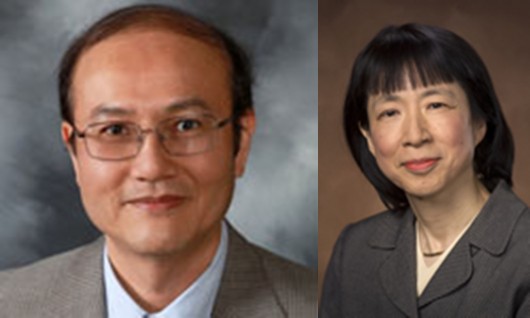
Fellowship to the National Academy of Inventors has been granted to both Ching-Shih Chen (left) and Yasuko Rikihisa (right) based on their achievements in cancer research and veterinary medical research, respectively. Credit: Courtesy of OSU
Two Ohio State researchers are being recognized for their work in medical fields, but their findings deal with very different kinds of patients.
Fellowship to the National Academy of Inventors has been granted to both Ching-Shih Chen and Yasuko Rikihisa based on their achievements in cancer research and veterinary medical research, respectively.
Chen, a professor of medicinal chemistry, urology and internal medicine, focuses his research on finding new ways to combat cancer, which has led to the creation of new cancer therapeutic agents.
“We do drug discovery research,” said Sam Kulp, one of Chen’s senior research staff members. “If at the early end you have drug discovery, then at the totally opposite end, it would be a drug on the market, for instance, that a doctor would prescribe.”
Two of Chen’s anti-cancer drugs are being clinically tested at the OSU James Cancer Hospital. Many other anti-cancer compounds are in preclinical development in his laboratory.
His approach to finding a cancer cure combines multiple disciplines, such as molecular and cellular biology, molecular pharmacology and synthetic molecular chemistry.
“We have chemists that are synthesizing molecules, and then there’s quite a few biochemists, molecular biologists, biologists who are testing the activities of those new molecules to see if they have the activities against cancer cells,” Kulp said.
Chen serves as the Lucius A. Wing Chair of Cancer Research and Therapy at the Comprehensive Cancer Center and has been a Fellow of the American Association for the Advancement of Science since 2004.
“I think it (the NAI Fellowship) recognizes over the long-term his creativity and dedication to his research,” Kulp said. “He not only works hard, but he’s … one of the most collaborative researchers I’ve seen.”
OSU’s Office of Research named Chen an Innovator of the Year in 2010, the same year he was awarded the Distinguished Scholar Award. He holds 11 other national and institutional honors as well as 24 patents dealing with therapeutic agents.
“He has a long history of being a very dedicated and outstanding mentor to many graduate students and postdocs,” Kulp said.
Chen was unable to be reached for comment via email because he was out of the country.
Rikihisa, a distinguished professor of veterinary biosciences, has found new ways to diagnose more tick-borne zoonotic diseases, or diseases that can be passed from ticks to animals, which can then transmit them to humans.
“She studies a group of bacteria that causes disease in humans, horses, dogs and other species,” said Dr. Michael Oglesbee, department chair of veterinary biosciences.
Rikihisa figured out how to grow these bacteria in the lab, allowing for further and closer study in a more controlled environment.
“When she grew these things and started to be able to culture these species, she began to identify proteins on the outer membrane of these and characterize these proteins,” said Jean Schelhorn, director of commercialization and industry collaboration for the College of Veterinary Medicine.
This group of bacteria can nest within cells, and furthermore, they can be replicated along with the cells, causing diseases in the host.
“The real challenge to the medical community in controlling these types of infections is that it’s very difficult to detect and eliminate these organisms,” Oglesbee said.
Rikihisa said the resiliency of some strains of bacteria makes diseases hard to treat.
“These bacteria modify and manipulate host cells in order to survive and cause disease,” Rikihisa said.
Rikihisa’s research on these bacteria is now being used commercially in diagnostic tests, particularly for dogs, Schelhorn said.
“If you take your dog to the vet, they will test it for tick-borne diseases,” he said. “It allows them in just a few minutes to know that the dog has been exposed to these tick-borne diseases.”
Schelhorn added that this is “the highest volume diagnostic test used throughout the world in veterinary medicine.”
Rikihisa said it is a “great honor” to be recognized by the National Academy of Inventors.
“We do a lot of research, and for it to be translated into something useful is very nice,” she said.
Rikihisa was named an Innovator of the Year in 2011 by OSU and was elected to the National Academy of Sciences in 2012.
“She is an incredibly productive investigator,” Oglesbee said. “She produces exceptionally high-quality work, which also benefits the students that go through her laboratory.”
The NAI was founded in 2010 to give recognition to inventors, advocate the power of academic innovation and foster growth in students hoping to become innovators, according to its website.
Fellows must be nominated by their peers on the grounds of great contributions to “creating or facilitating outstanding inventions that have made a tangible impact on quality of life, economic development, and the welfare of society,” according to the NAI’s website.


